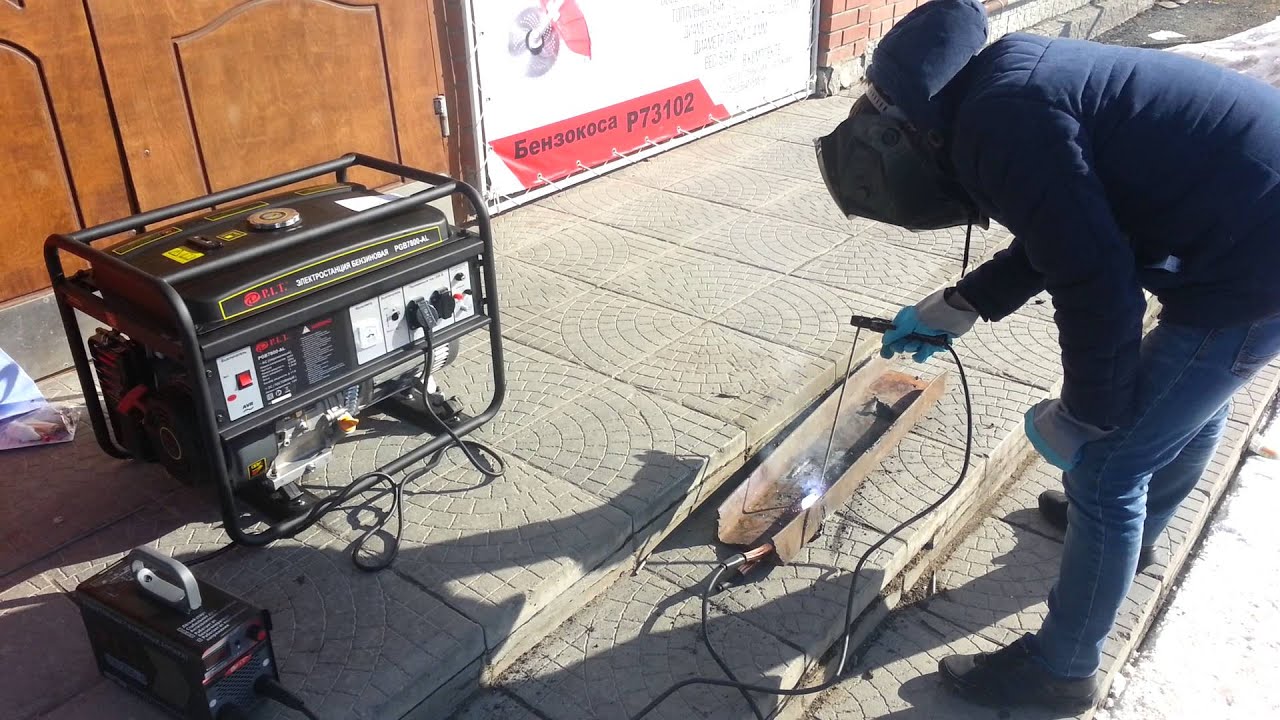Rating of the best welding generators for 2022

The main advantage of the welding generator is that it can be used in places that are not available for the work of a fellow powered by an electrical outlet. It is quite possible to install it in a country house, a construction site, as well as in a territory that is not provided with a connection to electricity. The equipment in question can consume different fuels - gas, gasoline or diesel, but the principle of generating electricity is the same for all of them - the conversion of vapors during the combustion of fuel into mechanical energy, which then turns into electricity.

Content [Hide]
Welding generators - general information
The modern market of the devices in question can offer three types of them, which are designed for operation in combination with a welding machine. They can be household, synchronous or welding. The purpose of the first type speaks for itself and it is not fully designed to work with welding. The second type is a standard voltage source capable of supporting the operation of welding inverters and household appliances. The third type refers to small-sized devices in which, as an addition, a welding machine is integrated. Due to the fact that they require very little space, they are convenient to transport and place in tight spaces. It must be remembered that generators with a built-in welding machine may differ in terms of power parameters. Therefore, the welding model of the generator should be selected based on the tasks ahead.
Principle of operation
It is no secret that the task of any generator, be it gas, gasoline or diesel, is to generate and transmit electricity. However, the equipment under consideration can be divided into many varieties depending on the classification criterion.Specifically for welding, special models of generators are traditionally used, but they can also support the work of other electrical devices. The principle of operation of a generator device for welding, by and large, is similar to the operation of a classic household power plant that consumes fuel. But it differs in that it needs to constantly maintain the voltage at the set level necessary for the burning of the welding arc. Otherwise, its operation is not very complicated: the engine, due to the processing of fuel, transforms heat energy into mechanical energy, and a special module of the device converts mechanical energy into electricity.
Thus, it is the output power that is the main technical characteristic of the welding generator set. As a rule, information about this is indicated directly on the device case or in its accompanying documents (instructions). At the same time, it is necessary to take into account that the total power of the unit should exceed the need of the welding machine itself by 25-30%, because long-term work on low-power equipment in intensive mode can damage the working equipment.
Most often, generator sets for gasoline fuel are used for welding machines. They are not much different from their counterparts, but the principle of operation follows the following pattern. At the moment of ignition of the welding arc, a welding current is supplied to the armature winding, which will ensure the stability of the welding arc throughout the entire working process. The current is also created due to the transformation of energy resulting from the rotation of the crankshaft in an internal combustion engine, which makes it possible to convert mechanical energy into electricity.
Power as the main parameter
As a rule, all electric generators are classified based on their rated power. So, it is customary to distinguish:
- Household models (0.5-5 kilowatts) are small-sized power plants that are designed to provide power to household electrical appliances, small power tools and household lighting equipment. Such units are characterized by small size and relatively modest weight, which greatly simplifies the procedure for their movement.
- Synchronous (5-10 kilowatts) - are universal and reliable sources of electricity supply that have the power level that can power household appliances and supply current for the welding arc of the unit of the same name. Also, such equipment can provide electricity to a small private house or summer cottage.
- Welding machines (4-20 kilowatts) are a technically complete complex consisting of a power plant and an inverter. Today, there are both mobile stations and stationary samples of welding power generators.
Calculation of the required power
In terms of its power, the fuel generator for the welding machine must be properly correlated with the maximum value that the welding arc consumes. However, some manufacturers sometimes do not list this value for their products, so the user (may) have to do the necessary calculations themselves. Accordingly, having determined the power consumed by the welding machine, it is possible to select the necessary electric generator.
IMPORTANT! Welding power generators with built-in inverters are especially good because all the modules installed on them are not only pre-adjusted to each other at the factory, but also selected taking into account each other's characteristics.
The calculation of the voltage required for the arc should be carried out in the following steps:
- The maximum power of the welding unit is determined - it can be found in the accompanying documents or it is directly indicated on the unit itself. Visually, it may look like this: in the inscription “from 10 to 160 Amperes”, the last indicator (160 A) will be the coefficient necessary for calculations.
- Known components are multiplied - the previously determined coefficient is multiplied by the arc voltage of 25 volts.
- Obtaining the final value - the previously multiplied indicators are divided by the efficiency of the welding machine (usually it is 0.85%).
Thus, for a welding unit with a voltage of 160 A, a generator with a power of 4.7 kilowatts is required (160 A x 25 V / 0.85 efficiency = 4705 watts).
However, the device will almost never work at maximum load, so the average power indicators of the equipment will be enough. The average indicator can be calculated by multiplying the obtained power indicator by the average duration of the operating time. At the same time, it is still worth adding 20-30% in reserve to the most minimal calculations.
In addition, when calculating the power, you should pay attention to what diameter electrodes you have to use. This is necessary in order to match the output power of the welding power generator. For example, for equipment that produces a power of 2.5 kilowatts, electrodes with a cross section of 2 millimeters are perfect.On average, increasing the cross section of the electrode by one millimeter, you will have to use an electric generator with an increase in power by one kilowatt (2.5 kilowatts = an electrode by 2 millimeters, and, accordingly, an electrode by 3 millimeters = 3.5 kilowatts).
Use of welding generator sets as conventional
Indeed, such use of the equipment in question is allowed, but for this it is necessary to take into account some features of its connection, for example, to a home electrical network. The fuel synchronous power generator for the inverter converts the voltage in such a way that it gets rid of possible surges, trying to stabilize the wave. Therefore, some household appliances, such as a TV or computer, do not even require the use of protective devices, such as all kinds of electrical rectifiers. However, for medical equipment that is extremely sensitive to power surges, it is better not to use synchronous samples.
Models with a built-in inverter (welding) are an order of magnitude higher than all their counterparts, because everything in them is already balanced in advance even during the factory assembly process. Moreover, they are best able to maintain a constant voltage, preventing it from fluctuating. They can be used to provide energy for any equipment, including medical ones.
Operating rules
When operating a gas generator with a built-in inverter (as well as any other), you should clearly follow all the instructions, recommendations and instructions established by the manufacturer. Usually, when you turn it on for the first time, you need to “warm up” the equipment so that it reaches the level of its normal operation.To do this, you need to spend about 20 hours of active use, however, the total load on the equipment should not exceed more than 50% of the rated power. Among other conditions, environmental conditions should be taken into account - if the equipment is supposed to be used in high-altitude or mountainous areas, then it is necessary that the unit is equipped with an appropriate carburetor that can take into account the increased oxygen content in the air during operation.
Also, it is necessary to timely and properly perform the following actions:
- Check oil level and quality;
- Select the best type of fuel and organize normal storage conditions for it;
- Carry out timely refueling of the unit with fuel;
- Properly warm up and start the unit;
- Turn it off properly.
Particular attention should be paid to the procedure in case of emergency situations - such typical moments are usually described in the instructions.
Possible operational problems
During operation or commissioning of a welding generator set, the following common problems may occur:
- The power plant motor does not start - the problem may lie in the spark plugs or the fuel system;
- The engine suddenly stops - first of all, you need to check the fuel and air filters and measure the oil level;
- The power level is insufficient - perhaps the problem is the air filter (needs cleaning / replacement), or it is worth checking the piston rings for wear, or checking the quality of the fuel;
- The motor smoked - the general deterioration of the working mechanisms is possible, or the oil level is filled too high, or too much fuel is supplied;
- Increased oil consumption - this situation leads to wear on the piston rings or engine cylinder.
However, if appropriate preventive measures are taken in time and the device is properly cared for, then such problems can easily be avoided.
Care rules
When operating a welding generator set, remember that it needs proper maintenance. There are two main actions that should be done on a permanent basis:
- Regularly check the oil level, and if necessary, replenish it in a timely manner;
- Monitor the condition of the battery and recharge it in time (probably, charging activities will not have to be carried out very often, unless the device is operated in low temperatures).
The best place to place the equipment will be indoors, because on the street it can fall victim to heavy rainfall and fail before the time specified by the manufacturer. However, if it is not possible to place the device in a completely covered room, then making a special canopy for it would be a good solution.
Difficulties of choice
Having decided on the required power, directly at the time of buying a generator set, you need to pay attention to the following few points. If it is assumed that the equipment will work not only for welding purposes, but also, for example, provide electricity to a house or plot, it is preferable to stop your choice on a gas generator. In the case when the issue of finance is not very acute, then for both purposes (both industrial and household), the optimal solution would be the option of a gas generator with a built-in inverter - it will cope equally well with both domestic and industrial tasks.
Next, you should carefully select the type of engine:
- Two-stroke motors - their price is rather low, so devices based on them are more often purchased for domestic purposes and for performing rare welding work. They are poorly adapted to intense loads, have a relatively large number of restrictions on working conditions, but for rare use they are, in most cases, enough.
- Four-stroke motors - they provide increased power, have a built-in cooling system. A gas generator based on such an engine will obviously last much longer and will be able to perform a wider range of tasks with increased productivity.
The popularity among buyers of gas generators is due to the increased quality of the output voltage, which is directly related to the operation of the internal combustion engine, which is able to organize a uniform supply of torque to the mechanical rotor.
Nevertheless, if the buyer does not have a lack of funds, then a model with a built-in inverter will be the best option for the following reasons:
- The highest rates of profitability at work;
- Extremely uniform voltage supply during operation;
- Automatic voltage reset when "idle" is detected;
- Increasing the applied voltage with increasing load intensity.
In addition, in the built-in inverter models, most of the functions are automated, which significantly reduces fuel consumption. This quality makes them the undisputed leader in the choice of such equipment.
Rating of the best welding generators for 2022
Lower price segment
2nd place: "DDE GW200 917-484"
votes 0
This model, although it has American roots, is produced in Chinese factories under license.However, this circumstance does not prevent him from being a strong "average", with an easy start, a strong frame and normal performance. Able to endure a few natural precipitation. The start can be carried out both with an electric starter and with a simple jerk of the cable. Monitoring the oil level and filling the tank with fuel is possible with the help of special sensors. The maximum current is 200 A with a minimum of 50 A. Transportation is carried out by means of wheels on the body, and its relatively low weight (98 kg) makes it convenient to move. The established cost for retail chains is 59,400 rubles.

- Sturdy steel frame;
- Indicators for oil and gasoline;
- Existence of protection against an overheat.
- Equipped with only one 220 V outlet.
1st place: "Huter DY6500LXW"
votes 0
This sample of German production weighs 100 kilograms, has a four-stroke engine, which allows you to give a fairly stable voltage level. The current range for welding varies from 60 to 200 A. The design includes a copper winding, which reduces the risk of overheating of the device. Although there is an electric starter on the case, the battery for it will have to be purchased separately. It is characterized by quite economical fuel consumption - 2.1 liters of gasoline are consumed for one hour of work. Accordingly, with a tank of 22 liters, continuous operation will be 11 hours. The established retail price is 66,200 rubles.

- The presence of a voltmeter to control the readings;
- Fuel level sensor;
- Adequate cost.
- Supplied without battery with electric starter;
- Some noise during operation.
Video review of this generator:
Middle price segment
3rd place: FUBAG WHS 210 DC Honda 838240
votes 0
The maximum generated current for this welding sample is 210 A. At the same time, arc voltage can be reduced to 24 V. Gasoline level indicator and hour meter make it convenient to monitor important working conditions. In the presence of a large fuel tank of 25 liters, which makes it possible to non-stop cooking for half a day. Resistant to work under heavy loads. The design is equipped with a reinforced steel frame. The recommended cost for retail chains is 118,200 rubles.

- There is overload protection;
- Anti-vibration cushions are installed under the motor;
- You can cook on electrodes with a cross section of up to 5 millimeters.
- The set does not include wheels or handles.
Video review of the generator:
2nd place: "EuroPower EP200X1AC"
votes 0
This unit, with a rather small engine volume with a volume of 389 "cubes", is capable of delivering 11 horsepower, which makes it possible to generate a current of 200 A. The presence of an accurate oil level indicator allows you to monitor its condition and prevent "starvation". The power plant has four cycles and is relatively quiet (only 75 dB). Starting is carried out only with a manual starter, but this does not cause any particular problems. Works great on 4mm electrodes. There are two 220V sockets on the case. This is true when you need to use a drill or grinder during welding. Fuel consumption is 2.4 liters per hour. The recommended retail price is 140,000 rubles.

- Durable tubular frame;
- Rubber cushions under the motor against vibration;
- Two sockets.
- There is no hour meter.
1st place: "Robin-Subaru EB 6.5/400-W220R"
votes 0
The engine capacity in this system is 404 "cubes", it produces 9.5 horsepower. The four-stroke power plant maintains stable speed for various brewing ranges, providing constant current generation. The voltage applied to the arc can be artificially reduced, which is important when welding thin metal sheets. The maximum power reaches 220 A, with a fuel consumption of 2.3 liters per hour. Quietly works with electrodes up to 5 millimeters in diameter, which is enough for welding thick metal objects. The established price for store chains is 143,000 rubles.

- Reliable Japanese engine;
- Ability to cook with large electrodes;
- Presence of anti-vibration pillows.
- Very afraid of weather precipitation;
- There is no fuel consumption indicator.
The launch of this generator is in the video:
Highest price segment
2nd place: "MOSA MSG CHOPPER 4380"
votes 0
This model is very compact and perfect for frequent transportation. Although its engine is not large (only 125 “cubes”), it consistently delivers the required 165 A. To weld thicker objects, the arc voltage can be forcibly increased to 30 A. The power plant has only two cycles, but this is more than offset by high device mobility. There is a single 220V socket on the front panel. The fuel tank is small - some 3 liters, which is enough for 1.5 hours of work, but this is again done for the sake of mobility.The device itself weighs extremely little - about 28 kilograms and even one person is able to move it. Moreover, this process is facilitated by rubberized handles. You can also transport it by bike. The established cost for retail chains is 171,000 rubles.

- Economical fuel consumption (2 liters per hour);
- Arc ignition is also possible at idle;
- Small weight and ease of transportation.
- Missing fuel sensor;
- There is no hour indicator.
Generator at work:
1st place: "EuroPower EP400XE"
votes 0
This sample was made in Belgium, equipped with a powerful two-cylinder engine with a volume of 895 "cubes". Differs in the work of increased stability at any speed, which guarantees a smooth generation of current. Gasoline consumption is 6 liters per hour. Starting is carried out by means of a starter, the battery is supplied in the kit. The device allows you to confidently work with electrodes up to 6 millimeters. It has increased power, which, if necessary, can briefly rise to 400 A. In general, the sample can be described as a professional model for a large construction site. The established retail price is 660,000 rubles.

- Powerful four-stroke engine;
- Availability of sockets for 380V and 220V;
- Stable current.
- High fuel consumption (like a car);
- Extremely high cost.
Conclusion
The modern market of the devices in question is able to offer them a very wide range. Such equipment is in great demand, because it (in most cases) has a dual purpose - it can be used both for welding and for providing a specific facility with electricity.Moreover, welding generators have stable performance characteristics and can maintain operation at high loads for a long time. However, the choice of this equipment should be approached with all care, since the prices for it (even in the lower price segment) are far from small.
new entries
Categories
Useful
Popular Articles
-

Top ranking of the best and cheapest scooters up to 50cc in 2022
Views: 131660 -

Rating of the best soundproofing materials for an apartment in 2022
Views: 127699 -

Rating of cheap analogues of expensive medicines for flu and colds for 2022
Views: 124526 -

The best men's sneakers in 2022
Views: 124042 -

The Best Complex Vitamins in 2022
Views: 121946 -

Top ranking of the best smartwatches 2022 - price-quality ratio
Views: 114985 -

The best paint for gray hair - top rating 2022
Views: 113401 -

Ranking of the best wood paints for interior work in 2022
Views: 110327 -

Rating of the best spinning reels in 2022
Views: 105335 -

Ranking of the best sex dolls for men for 2022
Views: 104374 -

Ranking of the best action cameras from China in 2022
Views: 102222 -

The most effective calcium preparations for adults and children in 2022
Views: 102017









